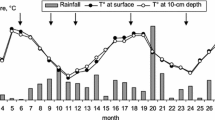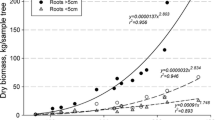Abstract
A growing demand for bioenergy from conventional forestry in Sweden will increase the need of nutrient compensation, that preferably should be made relatively shortly after harvesting and have no undesired side-effects. This study compared the effects of granulated wood ash (Ash), N-free, dolomite-based fertiliser (Vitality) and the green fraction of harvest residues (Residues) on the podsolic soil and soil solution of a young Norway spruce (Picea abies (L.) Karst) stand in SW Sweden. The treatments were applied three years after clear-felling and whole-tree harvesting. The soil solution was repeatedly sampled in the rooting zone 2–5 years after treatment. The soil study was performed 4 years after the Ash treatment and 3 years after Residues treatment and the last Vitality treatment (the Vitality treatment was applied on two occasions over 2 years). The Vitality treatment increased base saturation and effective CEC in the humus layer in relation to the other treatments, and also increased Ca and K concentrations in the soil solution. The Ash treatment resulted in higher exchangeable K concentration than Vitality in the litter layer, and Residues increased K concentrations in the soil water. No treatment influenced the KCl-exchangeable nitrate concentrations in the soil or the nitrate levels in the soil water. The results indicate that granulated wood ash could be used for long-term nutrient compensation without undesired short-term side-effects.


Similar content being viewed by others
References
Anonymous (2002) Recommendations for the Extractions of Forest Fuel and Compensation Fertilising. The Swedish Forest Agency, Jönköping Report 2002-3, pp. 1–20
Anonymous (2004) The Swedish Climate Strategy. Checkpoint 2004. The Swedish Environmental Protection Agency and the Swedish Energy Agency. ISBN 91-620-5418-x
Anonymous (2008a) Energy in Sweden 2008. ET 2008:20, The Swedish Energy Agency, Stockholm, Sweden. 56 pp
Anonymous (2008b) Rundvirkes- och skogsbränslebalanser för år 2007—SKA-VB 08. The Swedish Forest Agency, Meddelande 4-2008. (In Swedish.)
Anonymous (2008c) Rekommendationer vid uttag av avverkningsrester och askåterföring. The Swedish Forest Agency, Meddelande 2-2008, 22 pp. (In Swedish.)
Arvidsson H (2001) Wood ash application in spruce stands. Effects on ground vegetation, tree nutrient status and soil chemistry. Dissertation, Swedish University of Agricultural Sciences. Silvestria 221, ISBN 91-576-6305-X
Arvidsson H, Lundkvist H (2002) Needle chemistry in young Norway spruce stands after application of crushed wood ash. Plant Soil 238:159–174
Arvidsson H, Lundkvist H (2003) Effects of crushed wood ash on soil chemistry in young Norway spruce stands. For Ecol Manage 176:121–132
Baes CF, Mesmer RE (1976) The hydrolysis of cations. Wiley, New York, pp 112–123
Bergholm J, Jansson P-E, Johansson U, Majdi H, Nilsson L-O, Persson H, Rosengren-Brinck U, Wiklund K (1995) Air pollution, tree vitality and forest production—the Skogaby project. In: Nilsson L-O, Hüttl RF, Johansson UT, Mathy P (Eds) Nutrient uptake and cycling in forest ecosystems. European Commission, Ecosystems Research Report, 21, pp. 69–87
Bergholm J, Berggren D, Alavi G (2003) Soil acidification induced by ammonium sulphate addition in a Norway spruce forest in southwest Sweden. Water Air Soil Pollut 148:87–109
Callesen I, Ingerslev M, Raulund-Rasmussen K (2007) Dissolution of granulated wood ash examined by in situ incubation: effects of tree species and soil type. Biomass Bioenergy 31:693–699
Clarholm M (1994) Granulated wood ash and a N-free fertilizer to a forest soil—effect on P availability. For Ecol Manage 66:127–136
Egnell G, Leijon B (1999) Survival and growth of planted seedlings of Pinus sylvestris and Picea abies after different levels of biomass removal in clear-felling. Scand J For Res 14:303–311
Egnell G, Valinger E (2003) Survival, growth and growth allocation of planted Scots pine trees after different levels of biomass removal in clear-felling. For Ecol Manage 177:65–74
Ei Make M (2000) Granulated fly ash—a resource for mitigation of soil impoverishment. In: Base cations in relation to weathering of phyllosilicates and forest management in Swedish forest ecosystems. PhD Thesis, Swedish University of Agricultural Sciences, 2000
Eriksson HM (1998a) Short-term effects of granulated wood ash on forest soil chemistry in SW and NE Sweden. Scand J For Res (Suppl. 2):43–55
Eriksson J (1998b) Dissolution of hardened wood ashes in forest soils: studies in a column experiment. Scand J For Res (Suppl. 2):23–32
Fölster J, Bringmark L, Lundin L (2003) Temporal and spatial variations in soil water chemistry at three acid forest sites. Water Air Soil Pollut 146:171–195
Frank J, Stuanes AO (2003) Short-term effects of liming and vitality fertilization on forest soil and nutrient leaching in a Scots pine ecosystem in Norway. For Ecol Manage 176:371–386
Holmberg SL, Lind BB, Claesson T (2000) Chemical composition and leaching characteristics of granules made of wood ash and dolomite. Environ Geol 40(1–2):1–10
Hyvönen R, Olsson BA, Lundkvist H, Staaf H (2000) Decomposition and nutrient release from Picea abies (L.) Karst. and Pinus sylvestris L. logging residues. For Ecol Manage 126:97–112
Jacobson S, Kukkola M, Mälkönen E, Tveite B, Möller G (1996) Growth response of coniferous stands to whole-tree harvesting in early thinnings. Scand J For Res 11:50–59
Jacobson S, Högbom L, Ring E, Nohrstedt H-Ö (2004) Effects of wood ash dose and formulation on soil chemistry at two coniferous forest sites. Water Air Soil Pollut 158:113–125
Kimmins JP (1977) Evaluation of the consequences for future tree productivity of the loss of nutrients in whole-tree harvesting. For Ecol Manage 1:169–183
Lundborg A (1997) Reducing the nitrogen load: whole-tree harvesting. Ambio 26:387–392
Lundkvist H (1998) Wood ash effects on enchytraeid and earthworm abundance and enchytraeid cadmium content. Scand J For Res (Suppl. 2):86–95
Mahmood S, Finlay RD, Wallander H, Erland S (2002) Ectomycorrhizal colonisation of roots and ash granules in a spruce forest treated with granulated wood ash. For Ecol Manage 160:65–74
Mälkönen E (1976) Effects of whole-tree harvesting on soil fertility. Silva Fennica 10:157–164
Nilsson SI, Miller GH, Miller JD (1982) Forest growth as possible cause of soil and water acidification: and examination of the concepts. Oikos 39:40–49
Olsson B, Westling O (2006) Skogsbränslecykelns näringsbalans. The Swedish Environmental Research Institute (IVL) Report B 1669. [The element mass balance of the forest energy—wood ash cycle.] (In Swedish with English summary.)
Olsson M, Rosén K, Melkerud P-A (1993) Regional modelling of base cation losses from Swedish forest soil due to whole-tree harvesting. Appl Geochem 8(Suppl. 2):189–194
Olsson BA, Bengtsson J, Lundkvist H (1996) Effects of different forest harvest intensities on the pools of exchangeable cations in coniferous forest soils. For Ecol Manage 84:135–147
Olsson BA, Lundkvist H, Staaf H (2000) Nutrient status in needles of Norway spruce and Scots pine following harvesting of logging residues. Plant Soil 223:161–173
Palviainen M, Finer L, Kurka A-M, Mannerkoski H, Piirainen S, Starr M (2004a) Release of potassium, calcium, iron and aluminium from Norway spruce, Scots pine and silver birch logging residues. Plant Soil 259:123–136
Palviainen M, Finer L, Kurka A-M, Mannerkoski H, Piirainen S, Starr M (2004b) Decomposition and nutrient release from logging residues after clear-cutting of mixed boreal forest. Plant Soil 263:53–67
Perkiömäki J, Fritze H (2005) Cadmium in upland forests after vitality fertilization with wood ash—a summary of soil microbiological studies into the potential risk of cadmium release. Biol Fertil Soils 41:75–84
Ring E, Jacobson S, Nohrstedt H-Ö (2006) Soil-solution chemistry in a coniferous stand after adding wood ash and nitrogen. Can J For Res 36:15–163
Rosén K, Lundmark-Thelin A (1987) Increased nitrogen leaching under piles of slash—a consequence of modern forest harvesting techniques. Scand J For Res 2:21–29
Rosenberg O, Persson T, Högbom L, Jacobson S (2010) Effects of wood-ash application on potential carbon and nitrogen mineralisation at two forest sites with different tree species, climate and N status. For Ecol Manage. doi:10.1016/j.foreco.2010.05.006
Smolander A, Levula T, Kitunen V (2008) Response of litter decomposition and soil C and N transformations in a Norway spruce thinning stand to removal of logging residue. For Ecol Manage 256:1080–1086
Staaf H, Olsson BA (1994) Effects of slash removal and stump harvesting on soil water chemistry in a clearcutting in SW Sweden. Scand J For Res 9:305–310
Steenari BM, Marsic N, Karlsson LG, Tomsic A, Lindqvist O (1998) Long-term leaching of stabilized wood ash. Scand J For Res (Suppl. 2):3–16.
Steenari BM, Karlsson LG, Lindqvist O (1999) Evaluation of the leaching characteristics of wood ash and the influence of ash agglomeration. Biomass Bioenergy 16:119–136
Tripler CE, Kaushal SS, Likens E, Walter MT (2006) Patterns in potassium dynamics in forest ecosystems. Ecol Lett 9(451):466
Walmsley JD, Jones DL, Reynolds B, Price MH, Healey JR (2009) Whole tree harvesting can reduce second rotation forest productivity. For Ecol Manage 257:1104–1111
Wang P, Olsson BA, Lundkvist H (2007) Effects of wood ash, vitality fertilizer and logging residues on needle and root chemistry in a young Norway spruce stand. Scand J For Res 22:136–148
Weetman GF, Webber B (1972) The influence of wood harvesting on the nutrient status of two spruce stands. Can J For Res 2:351–369
Westling O, Örlander G, Andersson I (2004) Effekter av askåterföring till granplanteringar med ristäkt. The Swedish Environmental Research Institute (IVL) Report B 1552. [Effects of wood ash recycling on Norway spruce plantations following harvesting of logging residues] (In Swedish.)
Wilander A, Löfgren S (2003) Recovery from acidification in Swedish lakes and streams. K Skogs-o Lantbr akad Tidskr 142(18):49–55
Acknowledgements
We thank Ulf Johansson, director of the Tönnersjöheden Experimental Forest, and his staff for establishing and maintaining the experiment, as well as carrying out the samplings. We are grateful to Aili Irene Colbing, Kerstin Ahlström, Berit Solbreck, Thomas Grönqvist for laboratory assistance, Birgitta Vegerfors-Persson for help with statistical analyses of the soil water data and Mary McAfee for linguistic revision of the text. P-O Brandtberg gave valuable comments on a previous version of the text. Financial support was received from the Swedish Energy Agency.
Author information
Authors and Affiliations
Corresponding author
Additional information
Responsible Editor: Tibor Kalapos.
Rights and permissions
About this article
Cite this article
Wang, P., Olsson, B.A., Arvidsson, H. et al. Short-term effects of nutrient compensation following whole-tree harvesting on soil and soil water chemistry in a young Norway spruce stand. Plant Soil 336, 323–336 (2010). https://doi.org/10.1007/s11104-010-0484-1
Received:
Accepted:
Published:
Issue Date:
DOI: https://doi.org/10.1007/s11104-010-0484-1




